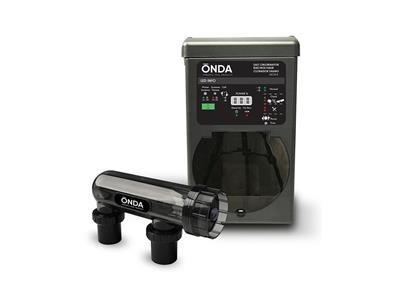The ONDA salt chlorinators use an alternative method of swimming pool disinfection based on the electrolysis process. When the solution of salt water passes through the electrolytic cell, sodium chloride (salt) is converted into dichlorine (gas), which becomes sodium hypochlorite (liquid chlorine) when dissolved in water.
| Characteristics |
|
| Good to know |
Salt electrolysis is not chlorine-free swimming. A salt electrolysis chlorinator disinfects without the sometimes unpleasant side effects of chlorine, such as odor, skin and eye irritations, making the condition of the swimming pool water more pleasant. The big advantage is that (slightly) salt water is very healthy for the skin. A condition for the proper functioning of a salt electrolysis system is a stable and correct pH value. That is why it is advisable to always apply a pH control in combination with a salt electrolysis chlorinator. Can only be used at private swimming pools. At the start of the swimming season, the prescribed number of grams of salt (depending on the type of dosage) must be dosed per liter of bath volume. Subsequently, only minimal salt needs to be added to compensate for the lost water (e.g. loss due to backwashing). When the salt water flows through the electrolysis cell, the clorinator ensures that the salt is converted into a disinfectant (sodium hypochlorite). The disinfectant is then converted back into salt and the cycle can start again, without loss of salt. The dosage can be set yourself. |
| Maximum Pool Volume | 110 m³ |
| Chlorine Production | 45 g/h |
| Salt Concentration | 4 g/l |
| Display | LED |
| pH measurement | No |
| Redox measurement | No |
| Free chlorine measurement | No |
| Temperature measurement | No |
| Additional contacts | No |
| Flow monitoring | Yes |
| Alarm notifications | Yes |
| Internet module | No |
| Protection Class | IPX4 |




